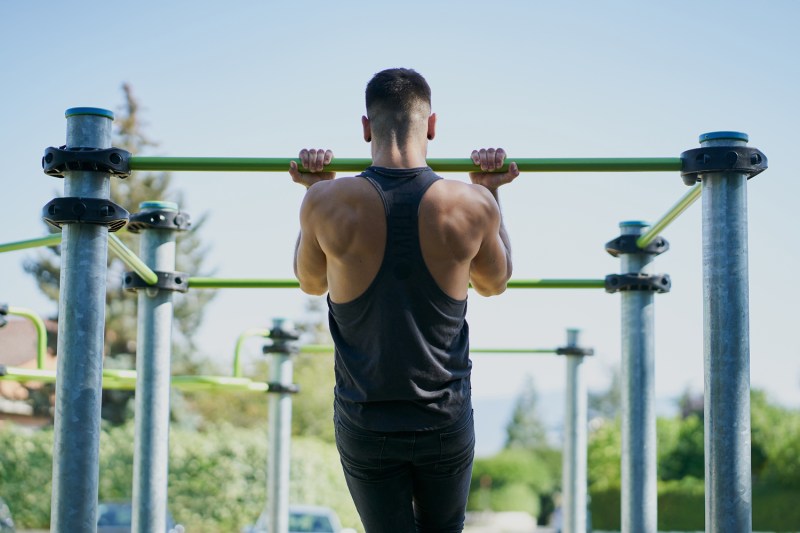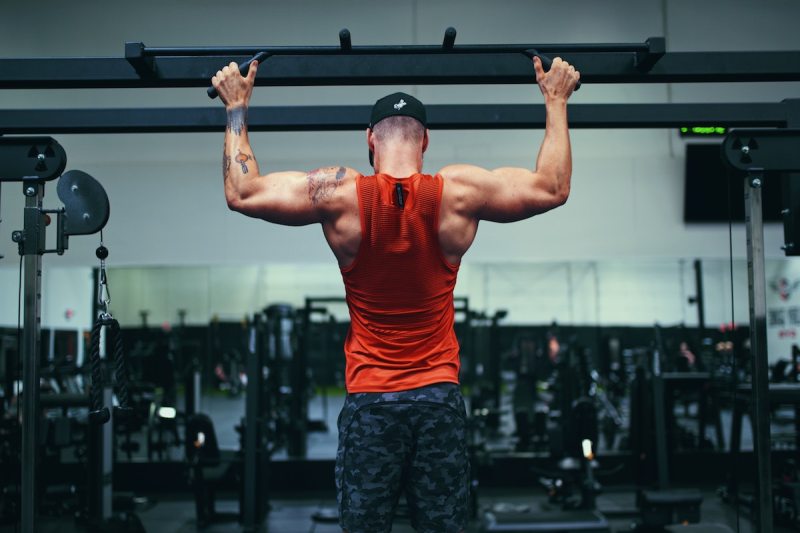There is no shortage of back-building exercises, from rows to pulldowns. However, if you’re trying to master your body weight, pull-ups, and chin-ups are your best bet for getting stronger and bigger back muscles. These exercises can be performed at home and do not require a lot of equipment. A pull-up bar at home will do the trick.
Chin-ups and pull-ups are versatile exercises that can be altered to emphasize muscle groups beyond the back. This makes them great for beginners and experienced fitness enthusiasts alike.
When it comes to deciding chin-up vs. pull-up, there are multiple factors to consider, including fitness goals and exercise preference. We’ll consider all the nuances and examine the differences as we go on.
What is better, chin-ups or pull-ups?

Chin-ups and pull-ups are both great exercises and deciphering the better one will depend on your preferences and the muscles you intend to target. The real difference between chin-ups and pull-ups is that you perform chin-ups with a supinated grip (palms facing you), while you perform pull-ups with a pronated grip (palms facing away from you).
Both exercises work the back muscles. Apart from the back muscles, chin-ups and pull-ups also task the muscles in front of the body, like the chest and biceps. Because of the supinated grip, however, chin-ups work the chest and biceps a lot more than traditional pull-ups.
Ultimately, if you want to build stronger biceps and improve your pulling strength, chin-ups are the better option. If, on the other hand, you want to build a bigger back and overall upper body strength, pull-ups will do the trick. You will also benefit from doing pull-ups and chin-ups in the same workout if you can fit them in.
Should beginners start with chin-ups or pull-ups?

When they start working out, many people find that they can do more chin-ups than pull-ups. Based on this, it may be expedient to start with the chin-up and build some pulling strength before jumping into pull-ups to continue building muscle and strength.
One reason chin-ups may be easier to perform is that the exercise allows your biceps to do a lot of the work through the supinated grip. However, beginners don’t have to start with any exercise. If you prefer pull-ups to chin-ups as a beginner, you can give it a go.
You’ll only perform a few reps in the beginning, but over time, you’ll get stronger through progressive overload, and the exercise will become less difficult.
How to do pull-ups

- Stand under a pull-up bar and grip the bar with your palms facing away, shoulder-width apart.
- Hang from the bar with your arms extended and feet off the ground. Tighten your core and keep your body straight while keeping your shoulders relaxed.
- Keeping your elbows pointed down and back, engage your back muscles, and pull your chest to the bar.
- Get your chin above the bar and pause briefly at the top.
- Slowly lower back to the starting position.
Recommended sets and reps: 4 sets of 8 to 12 reps
Muscles targeted: Traps, lats, rhomboids, and biceps
How to do chin-ups

- Stand under a pull-up bar and grip the bar with both palms facing you, hands shoulder-width apart.
- Hang from the bar with your arms straight and feet off the ground. Tighten your core and keep your body straight while keeping your shoulders relaxed.
- Keeping your elbows pointed down and back, engage your biceps and back muscles to pull your chest toward the bar.
- Get your chin above the bat and pause briefly at the top.
- Slowly lower back to the starting position.
Recommended sets and reps: 3 sets of 8 to 12 reps
Muscles targeted: Lats, biceps, rhomboids, traps, and chest
Tips for progressing to pull-ups and chin-ups

Use assisted variations
The National Academy of Sports Medicine suggests using a resistance band or an assisted machine if you’re just starting out with pull-ups and chin-ups. This is especially helpful if you can’t yet perform one rep of a pull-up or chin-up — assisted options will help you build strength and technique until you can do your first unassisted rep.
Perform scapular pull-ups/chin-ups
Scapular pull-ups and chin-ups strengthen the muscles around your shoulder blades and improve shoulder stability. This foundational strength is essential for performing both pull-ups and chin-ups.
To perform this scapular exercise, hang from the bar with your arms fully extended. Pull your shoulder blades down and back without bending your elbows, lifting your body slightly. Hold this position for a moment, then relax. This isn’t a full pull-up or chin-up, so it’s not as tasking but a good starting point.
Do lat pulldowns
Lat pulldowns mimic the pull-up and chin-up motion, allowing you to build strength in the same muscles. You can use lat pulldowns to get stronger if you can’t pull your entire body weight in a pull-up or chin-up. As you get closer to using your bodyweight for the lat pulldown, you can now try an unassisted pull-up or chin-up.
Utilize inverted rows
For inverted rows, you set up a barbell at waist height and lie underneath the bar, grabbing it with an overhand grip. Then, you pull yourself towards the bar until your chest touches it and lower your body back to the starting position. Keep your body in a straight line throughout this movement.
As you can imagine, inverted rows train the same muscles as pull-ups and chin-ups and are like assisted pull-ups/chin-ups. It’s an important exercise to include in your calisthenics routine if you’re just starting.
Frequently asked questions

How many chin-ups equal a pull-up?
Chin-ups and pull-ups are different exercises that target the muscles in varying degrees, so it’s not straightforward to say a specific number of chin-ups equals a pull-up. However, most people report that they find chin-ups easier to perform than pull-ups. So, if you’re a beginner, it might help to focus on chin-ups first.
Why can I do a chin-up but not a pull-up?
For the most part, both chin-ups and pull-ups target the back muscles, but chin-ups recruit the biceps muscles more. The assistance of the biceps in the chin-up makes it easier for most people than the pull-up.
Are chin-ups or pull-ups harder?
While both exercises are great for strength training and muscle building, the muscles they recruit determine how easy they are to perform. Chin-ups draw a lot of assistance from the biceps, taking some of the load from the back and making it easier.
Pull-ups, on the other hand, seem more difficult because they force you to bring yourself up to the bar, mostly using your back muscles.




